Statistical Analysis Assignment Solution: SOC 302, Fall 2024
VerifiedAdded on 2023/01/19
|30
|3963
|74
Homework Assignment
AI Summary
This document presents a comprehensive solution to a statistical analysis assignment (SOC 302), addressing multiple problems using various statistical methods. The solutions include paired t-tests to compare housing prices before and after a recession, Pearson's correlation to analyze relationships between variables like income and age, multiple regression to predict household income, independent t-tests to compare disciplinary problems in schools, two-way ANOVA to analyze the impact of prior arrests and community on sentence length, one-way ANOVA to compare hotel rates, and chi-square tests to examine the association between political affiliation and geographic regions. Each solution includes null and alternative hypotheses, the rationale for choosing the appropriate statistical test, descriptive statistics, SPSS output, and a final conclusion with statistical notation. The assignment covers a range of statistical concepts and their practical applications, providing a detailed analysis of each problem and its solution.
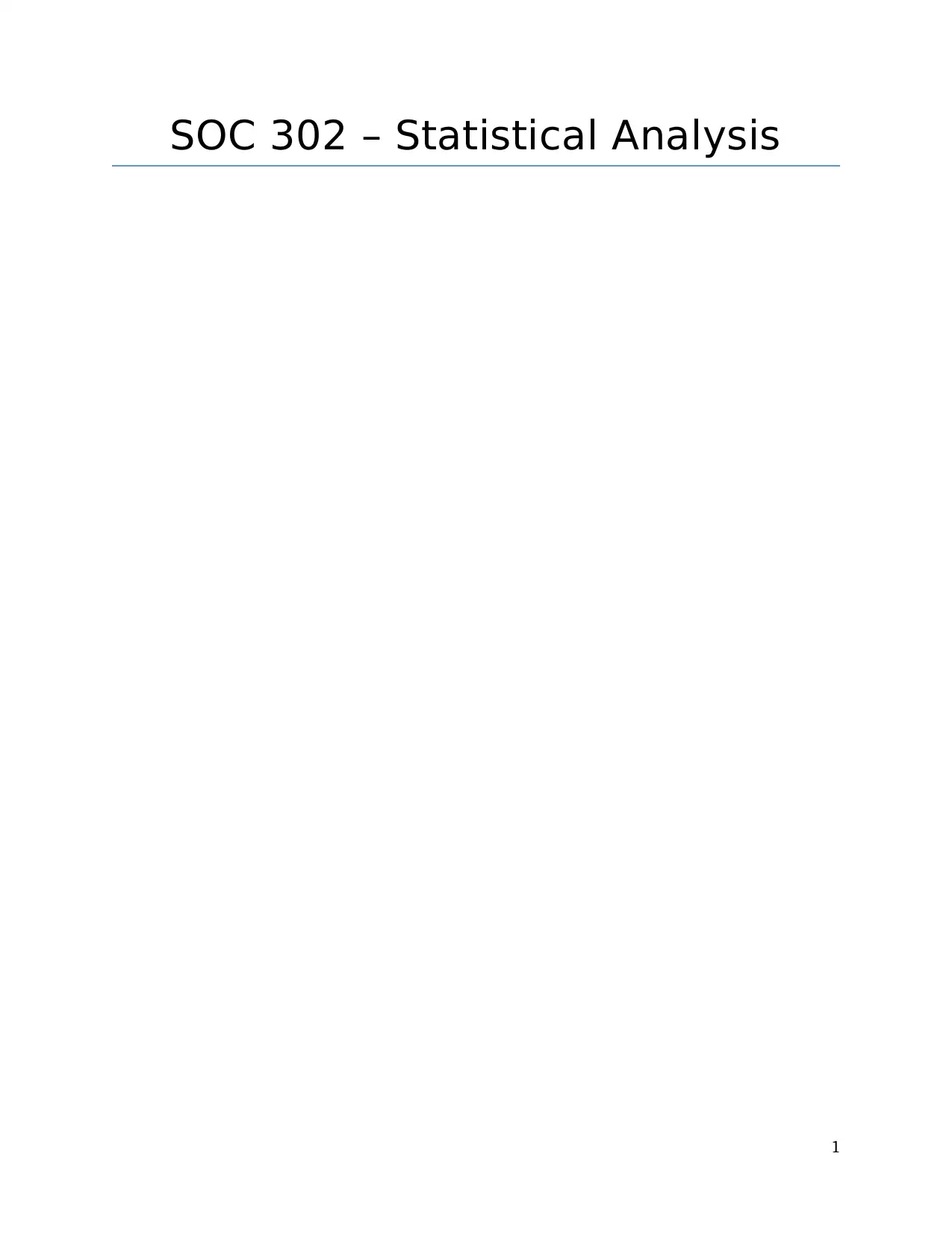
SOC 302 – Statistical Analysis
1
1
Paraphrase This Document
Need a fresh take? Get an instant paraphrase of this document with our AI Paraphraser
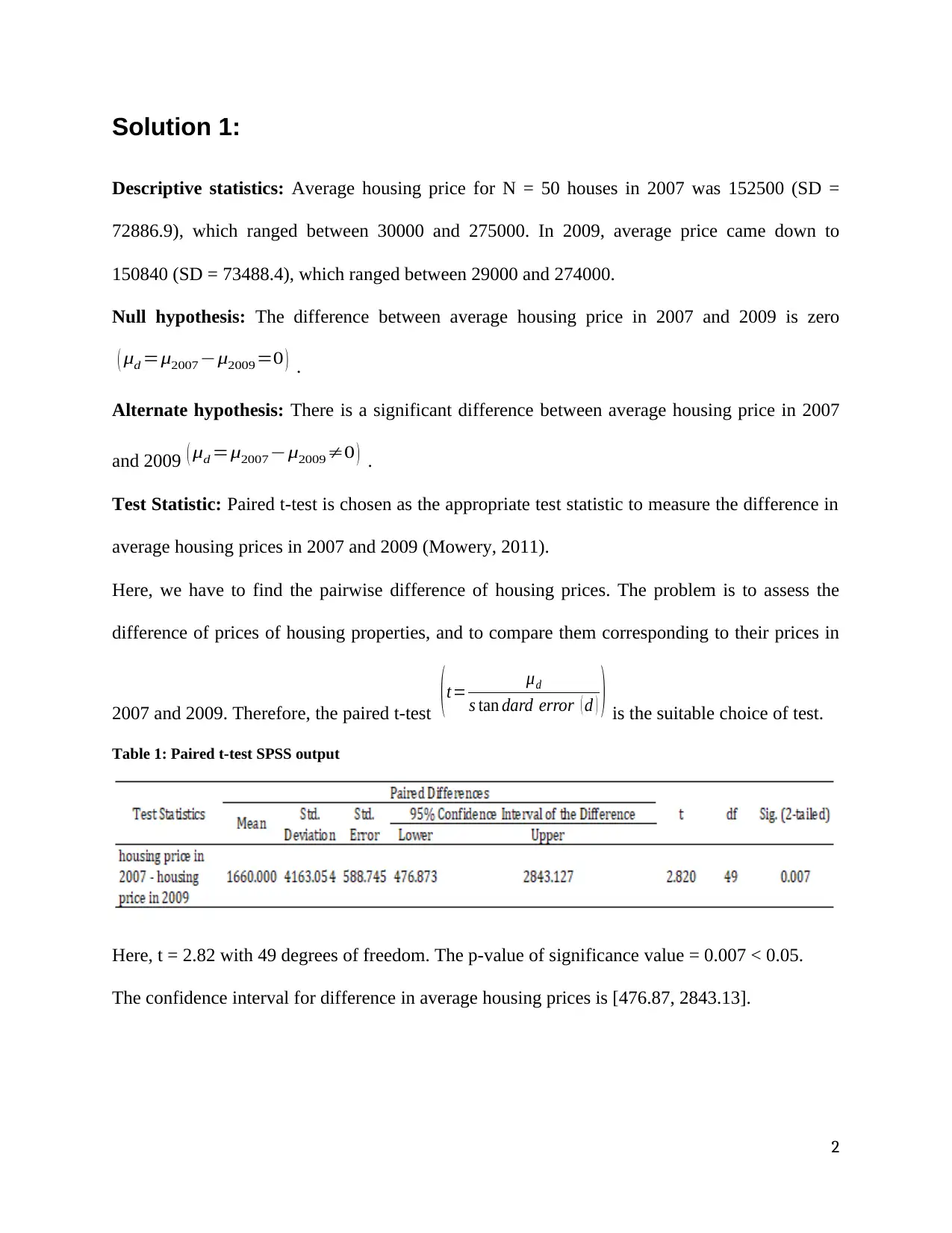
Solution 1:
Descriptive statistics: Average housing price for N = 50 houses in 2007 was 152500 (SD =
72886.9), which ranged between 30000 and 275000. In 2009, average price came down to
150840 (SD = 73488.4), which ranged between 29000 and 274000.
Null hypothesis: The difference between average housing price in 2007 and 2009 is zero
( μd =μ2007−μ2009=0 ) .
Alternate hypothesis: There is a significant difference between average housing price in 2007
and 2009 ( μd =μ2007−μ2009≠0 ) .
Test Statistic: Paired t-test is chosen as the appropriate test statistic to measure the difference in
average housing prices in 2007 and 2009 (Mowery, 2011).
Here, we have to find the pairwise difference of housing prices. The problem is to assess the
difference of prices of housing properties, and to compare them corresponding to their prices in
2007 and 2009. Therefore, the paired t-test ( t= μd
s tan dard error ( d ) ) is the suitable choice of test.
Table 1: Paired t-test SPSS output
Here, t = 2.82 with 49 degrees of freedom. The p-value of significance value = 0.007 < 0.05.
The confidence interval for difference in average housing prices is [476.87, 2843.13].
2
Descriptive statistics: Average housing price for N = 50 houses in 2007 was 152500 (SD =
72886.9), which ranged between 30000 and 275000. In 2009, average price came down to
150840 (SD = 73488.4), which ranged between 29000 and 274000.
Null hypothesis: The difference between average housing price in 2007 and 2009 is zero
( μd =μ2007−μ2009=0 ) .
Alternate hypothesis: There is a significant difference between average housing price in 2007
and 2009 ( μd =μ2007−μ2009≠0 ) .
Test Statistic: Paired t-test is chosen as the appropriate test statistic to measure the difference in
average housing prices in 2007 and 2009 (Mowery, 2011).
Here, we have to find the pairwise difference of housing prices. The problem is to assess the
difference of prices of housing properties, and to compare them corresponding to their prices in
2007 and 2009. Therefore, the paired t-test ( t= μd
s tan dard error ( d ) ) is the suitable choice of test.
Table 1: Paired t-test SPSS output
Here, t = 2.82 with 49 degrees of freedom. The p-value of significance value = 0.007 < 0.05.
The confidence interval for difference in average housing prices is [476.87, 2843.13].
2
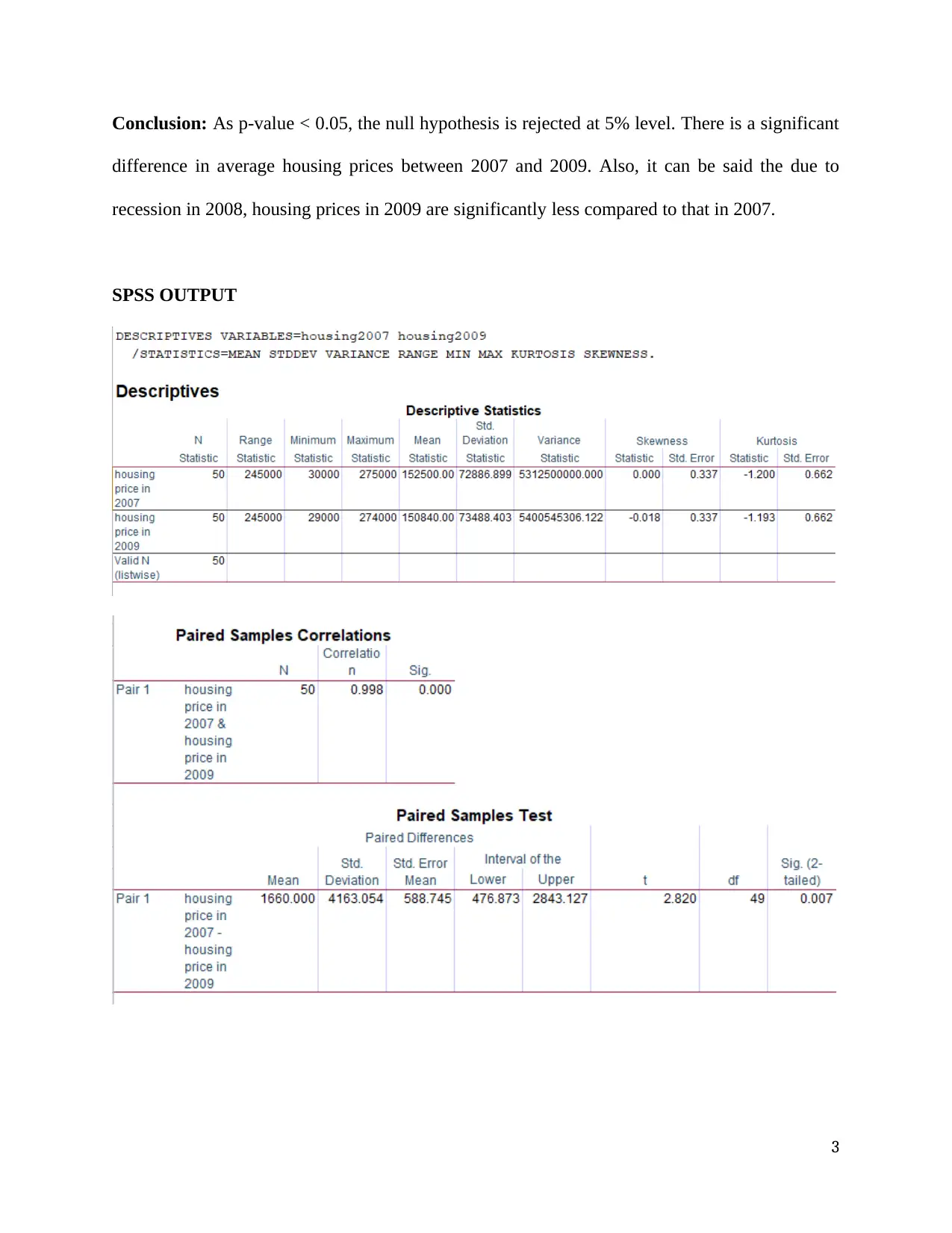
Conclusion: As p-value < 0.05, the null hypothesis is rejected at 5% level. There is a significant
difference in average housing prices between 2007 and 2009. Also, it can be said the due to
recession in 2008, housing prices in 2009 are significantly less compared to that in 2007.
SPSS OUTPUT
3
difference in average housing prices between 2007 and 2009. Also, it can be said the due to
recession in 2008, housing prices in 2009 are significantly less compared to that in 2007.
SPSS OUTPUT
3
⊘ This is a preview!⊘
Do you want full access?
Subscribe today to unlock all pages.

Trusted by 1+ million students worldwide
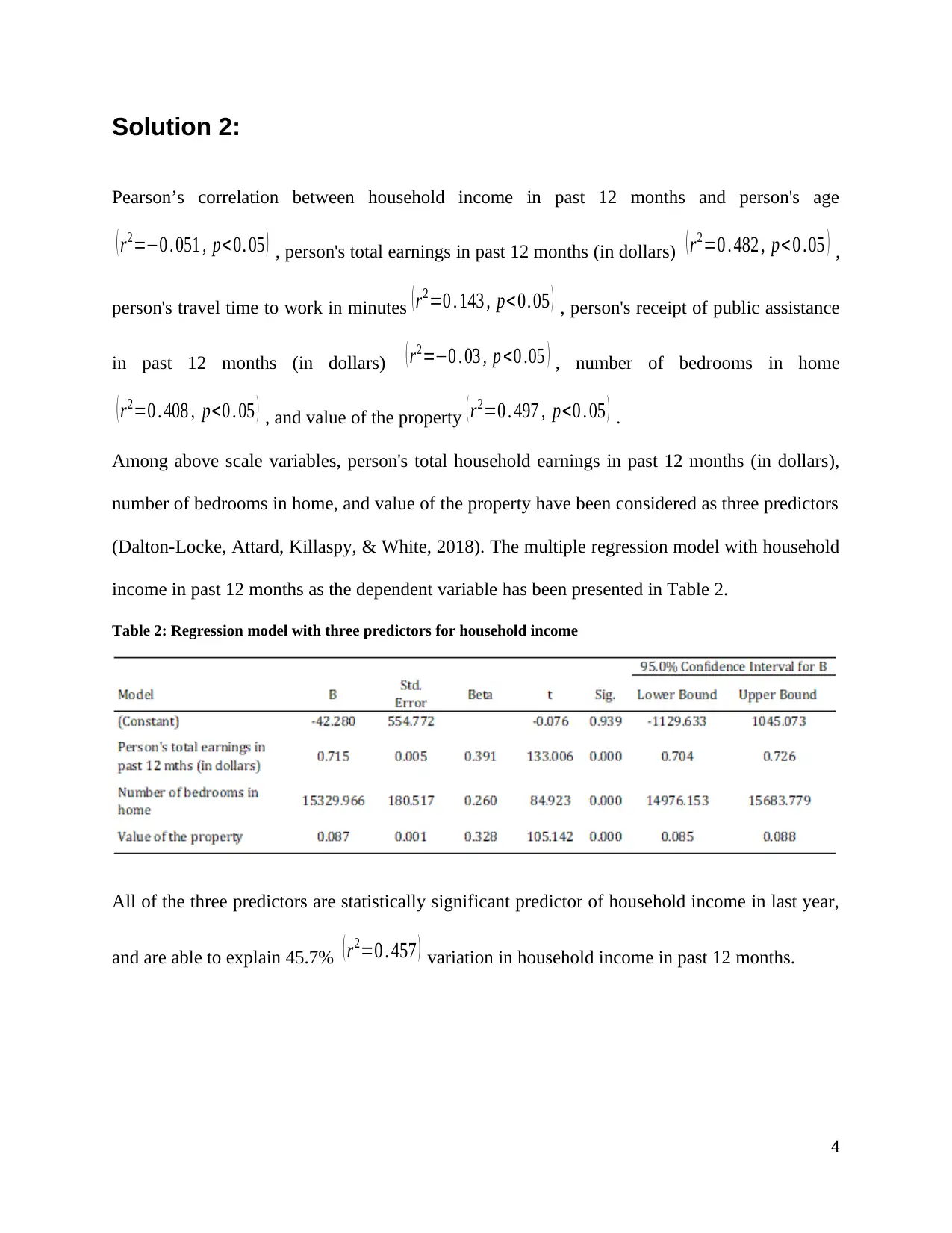
Solution 2:
Pearson’s correlation between household income in past 12 months and person's age
( r2=−0 . 051 , p< 0. 05 ) , person's total earnings in past 12 months (in dollars) ( r2=0 . 482 , p< 0 .05 ) ,
person's travel time to work in minutes ( r2=0 . 143 , p<0. 05 ) , person's receipt of public assistance
in past 12 months (in dollars) ( r2=−0 . 03 , p <0 .05 ) , number of bedrooms in home
( r2=0 . 408 , p<0 . 05 ) , and value of the property ( r2=0 . 497 , p<0 . 05 ) .
Among above scale variables, person's total household earnings in past 12 months (in dollars),
number of bedrooms in home, and value of the property have been considered as three predictors
(Dalton-Locke, Attard, Killaspy, & White, 2018). The multiple regression model with household
income in past 12 months as the dependent variable has been presented in Table 2.
Table 2: Regression model with three predictors for household income
All of the three predictors are statistically significant predictor of household income in last year,
and are able to explain 45.7% ( r2=0 . 457 ) variation in household income in past 12 months.
4
Pearson’s correlation between household income in past 12 months and person's age
( r2=−0 . 051 , p< 0. 05 ) , person's total earnings in past 12 months (in dollars) ( r2=0 . 482 , p< 0 .05 ) ,
person's travel time to work in minutes ( r2=0 . 143 , p<0. 05 ) , person's receipt of public assistance
in past 12 months (in dollars) ( r2=−0 . 03 , p <0 .05 ) , number of bedrooms in home
( r2=0 . 408 , p<0 . 05 ) , and value of the property ( r2=0 . 497 , p<0 . 05 ) .
Among above scale variables, person's total household earnings in past 12 months (in dollars),
number of bedrooms in home, and value of the property have been considered as three predictors
(Dalton-Locke, Attard, Killaspy, & White, 2018). The multiple regression model with household
income in past 12 months as the dependent variable has been presented in Table 2.
Table 2: Regression model with three predictors for household income
All of the three predictors are statistically significant predictor of household income in last year,
and are able to explain 45.7% ( r2=0 . 457 ) variation in household income in past 12 months.
4
Paraphrase This Document
Need a fresh take? Get an instant paraphrase of this document with our AI Paraphraser

The regression equation is,
Household income in past 12 months = 0.087*Value of the property + 15329.97*Number of
bedrooms in home + 0.715*Person’s total earning in past 12 months – 42.28
Descriptive statistics: Average household income in past 12 months for N = 65535 persons is
75248.32 (SD = 78596.49). Average number of bedrooms is 2.96 (SD = 1.33), and average value
of property is 297022.27 (SD = 186131.26).
Null hypothesis: H0 : ( βi=0 ) where βi s are the slopes of the predictors.
Alternate hypothesis: H A ( βi≠0 ) where βi s are the slopes of the predictors.
Test Statistic: The chosen test statistic was t-statistic, where the values have been obtained from
SPSS output.
Value of the property: t-stat =
β1
SE ( β1 ) =105.14, p-value < 0.05.
Number of bedrooms in home: t-stat =
β2
SE ( β2 ) =84.92, p-value < 0.05.
Person’s total earning in past 12 months: t-stat =
β3
SE ( β 3 ) =133.0, p-value < 0.05.
Conclusion: There was enough statistical evidence to reject the null hypotheses, concluding that
the predictors are linearly related to the dependent variable.
5
Household income in past 12 months = 0.087*Value of the property + 15329.97*Number of
bedrooms in home + 0.715*Person’s total earning in past 12 months – 42.28
Descriptive statistics: Average household income in past 12 months for N = 65535 persons is
75248.32 (SD = 78596.49). Average number of bedrooms is 2.96 (SD = 1.33), and average value
of property is 297022.27 (SD = 186131.26).
Null hypothesis: H0 : ( βi=0 ) where βi s are the slopes of the predictors.
Alternate hypothesis: H A ( βi≠0 ) where βi s are the slopes of the predictors.
Test Statistic: The chosen test statistic was t-statistic, where the values have been obtained from
SPSS output.
Value of the property: t-stat =
β1
SE ( β1 ) =105.14, p-value < 0.05.
Number of bedrooms in home: t-stat =
β2
SE ( β2 ) =84.92, p-value < 0.05.
Person’s total earning in past 12 months: t-stat =
β3
SE ( β 3 ) =133.0, p-value < 0.05.
Conclusion: There was enough statistical evidence to reject the null hypotheses, concluding that
the predictors are linearly related to the dependent variable.
5
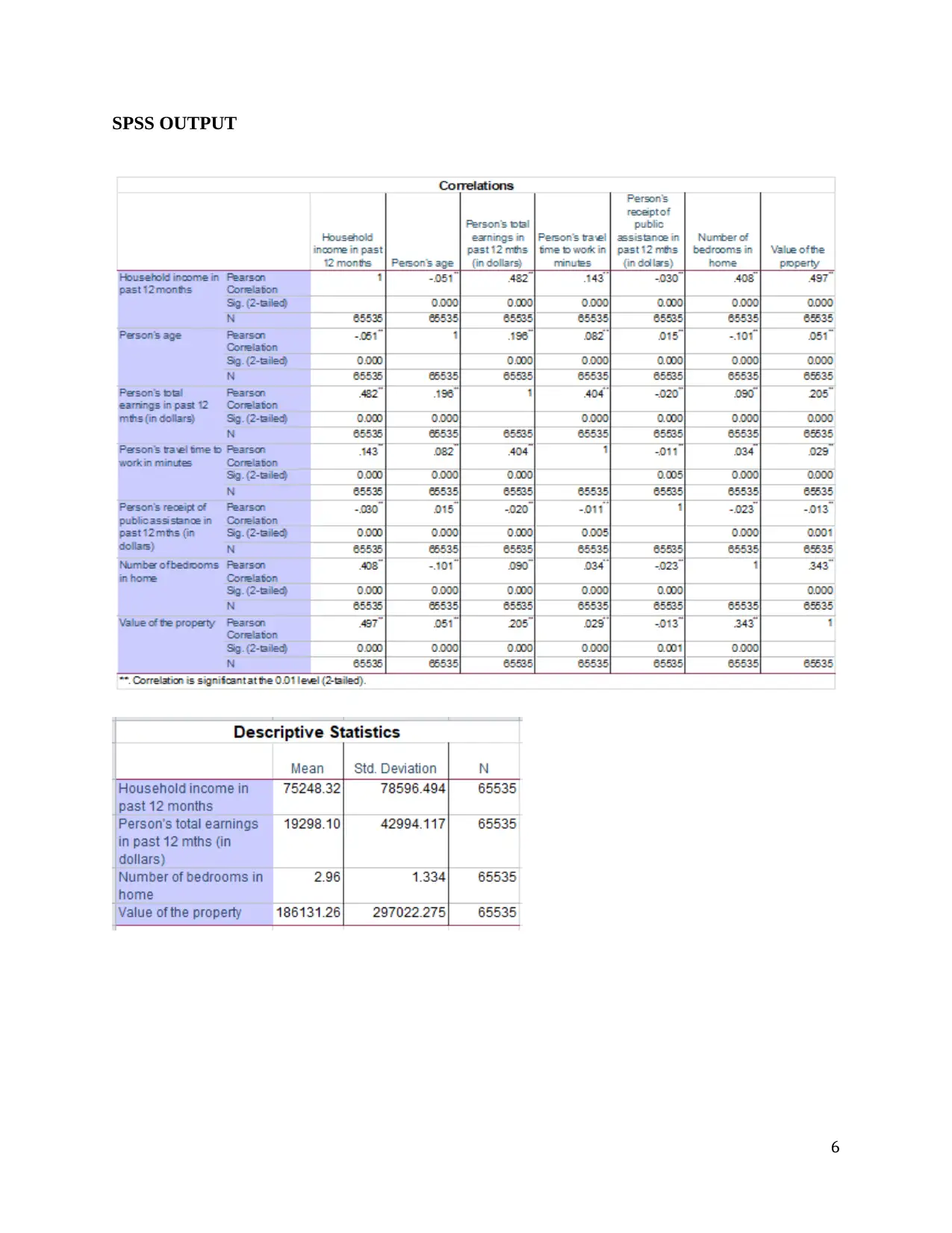
SPSS OUTPUT
6
6
⊘ This is a preview!⊘
Do you want full access?
Subscribe today to unlock all pages.

Trusted by 1+ million students worldwide
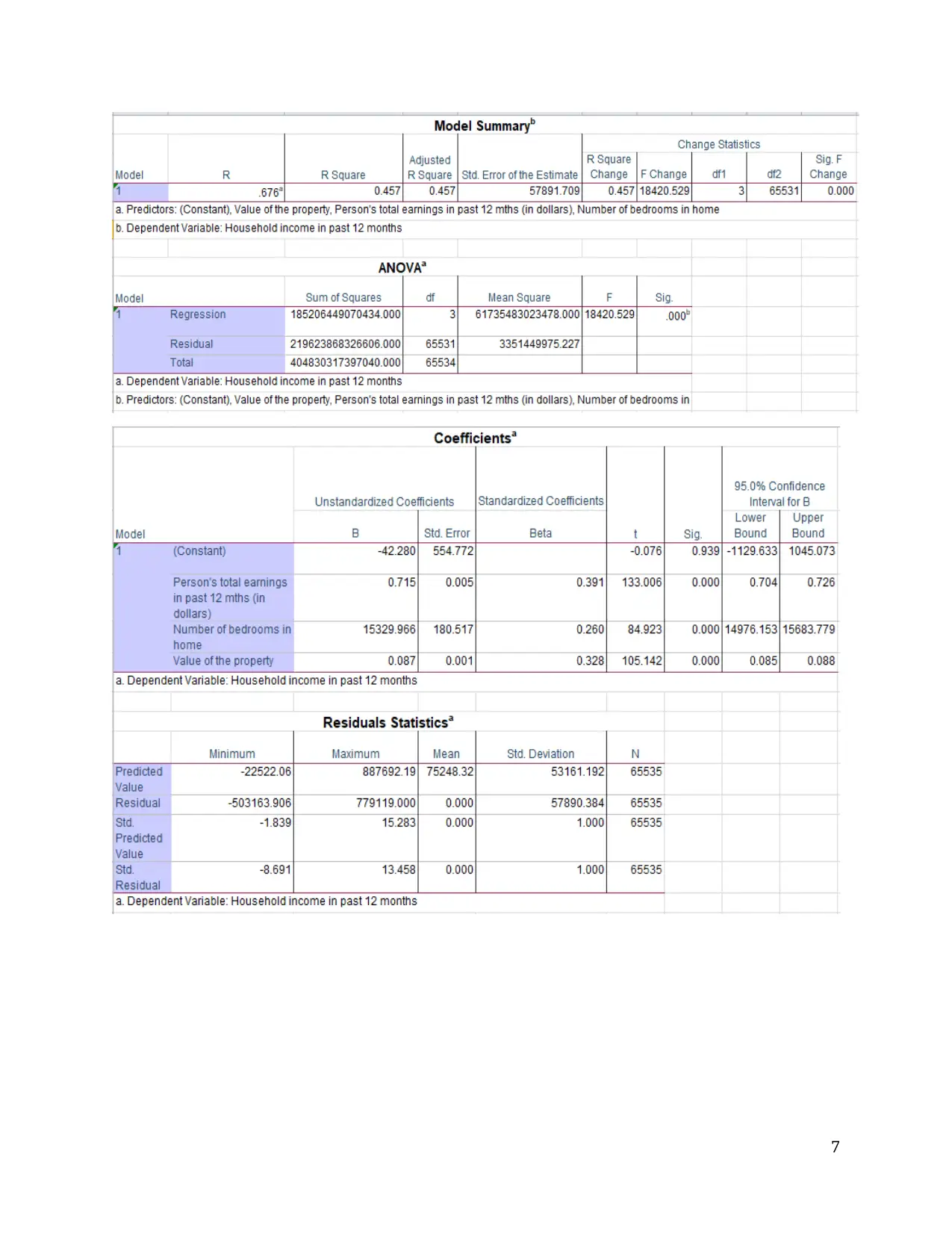
7
Paraphrase This Document
Need a fresh take? Get an instant paraphrase of this document with our AI Paraphraser
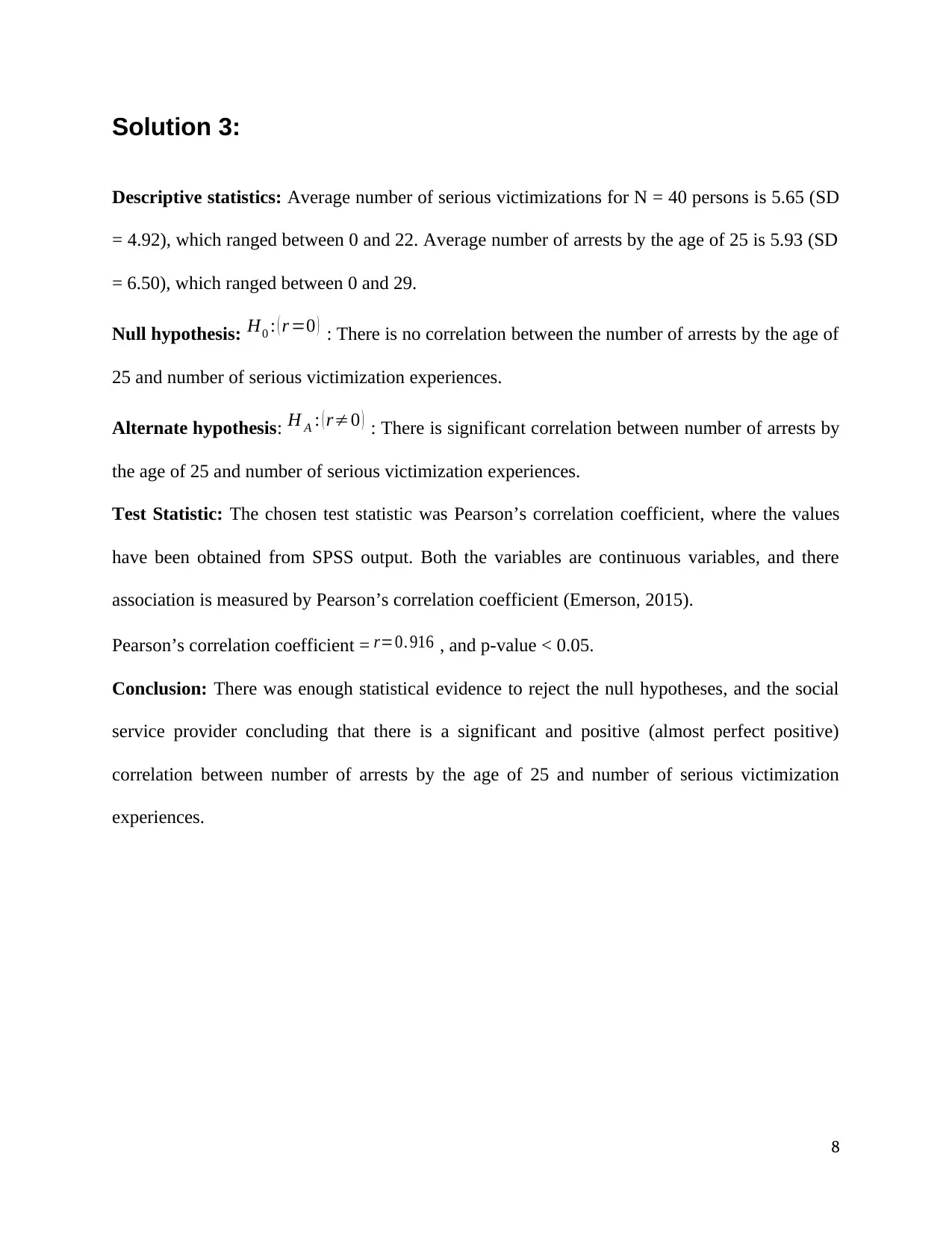
Solution 3:
Descriptive statistics: Average number of serious victimizations for N = 40 persons is 5.65 (SD
= 4.92), which ranged between 0 and 22. Average number of arrests by the age of 25 is 5.93 (SD
= 6.50), which ranged between 0 and 29.
Null hypothesis: H0 : ( r =0 ) : There is no correlation between the number of arrests by the age of
25 and number of serious victimization experiences.
Alternate hypothesis: H A : ( r≠0 ) : There is significant correlation between number of arrests by
the age of 25 and number of serious victimization experiences.
Test Statistic: The chosen test statistic was Pearson’s correlation coefficient, where the values
have been obtained from SPSS output. Both the variables are continuous variables, and there
association is measured by Pearson’s correlation coefficient (Emerson, 2015).
Pearson’s correlation coefficient = r=0. 916 , and p-value < 0.05.
Conclusion: There was enough statistical evidence to reject the null hypotheses, and the social
service provider concluding that there is a significant and positive (almost perfect positive)
correlation between number of arrests by the age of 25 and number of serious victimization
experiences.
8
Descriptive statistics: Average number of serious victimizations for N = 40 persons is 5.65 (SD
= 4.92), which ranged between 0 and 22. Average number of arrests by the age of 25 is 5.93 (SD
= 6.50), which ranged between 0 and 29.
Null hypothesis: H0 : ( r =0 ) : There is no correlation between the number of arrests by the age of
25 and number of serious victimization experiences.
Alternate hypothesis: H A : ( r≠0 ) : There is significant correlation between number of arrests by
the age of 25 and number of serious victimization experiences.
Test Statistic: The chosen test statistic was Pearson’s correlation coefficient, where the values
have been obtained from SPSS output. Both the variables are continuous variables, and there
association is measured by Pearson’s correlation coefficient (Emerson, 2015).
Pearson’s correlation coefficient = r=0. 916 , and p-value < 0.05.
Conclusion: There was enough statistical evidence to reject the null hypotheses, and the social
service provider concluding that there is a significant and positive (almost perfect positive)
correlation between number of arrests by the age of 25 and number of serious victimization
experiences.
8
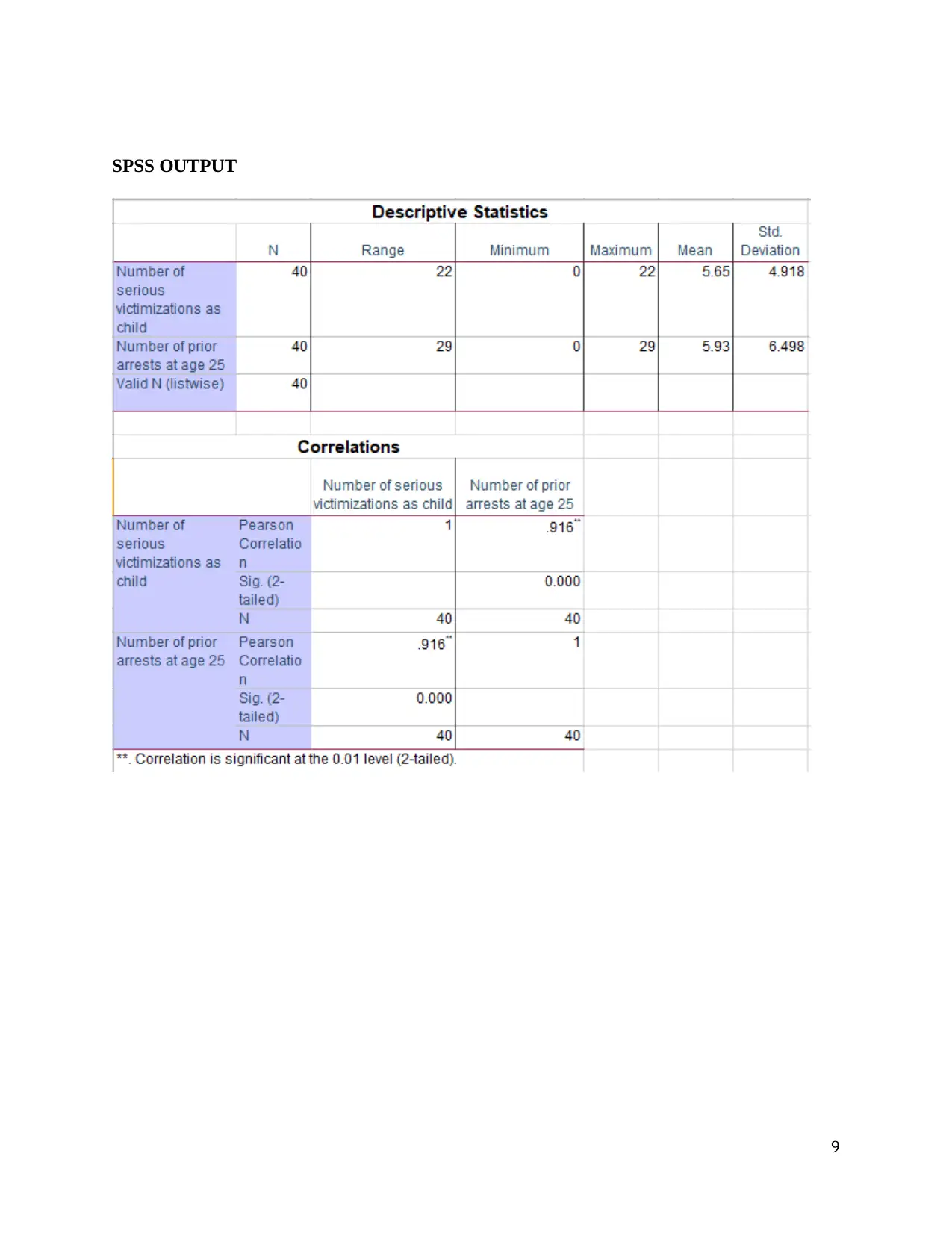
SPSS OUTPUT
9
9
⊘ This is a preview!⊘
Do you want full access?
Subscribe today to unlock all pages.

Trusted by 1+ million students worldwide
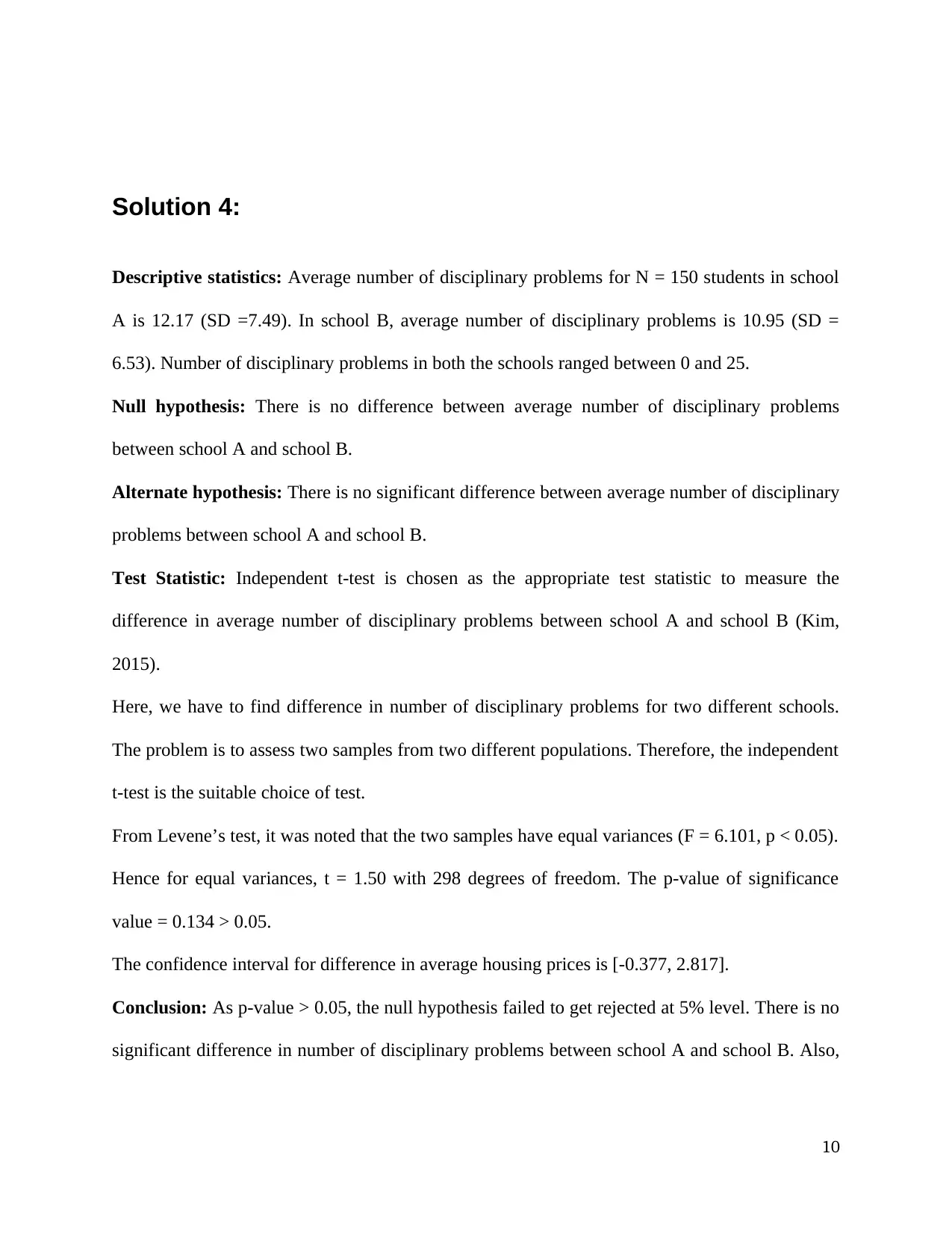
Solution 4:
Descriptive statistics: Average number of disciplinary problems for N = 150 students in school
A is 12.17 (SD =7.49). In school B, average number of disciplinary problems is 10.95 (SD =
6.53). Number of disciplinary problems in both the schools ranged between 0 and 25.
Null hypothesis: There is no difference between average number of disciplinary problems
between school A and school B.
Alternate hypothesis: There is no significant difference between average number of disciplinary
problems between school A and school B.
Test Statistic: Independent t-test is chosen as the appropriate test statistic to measure the
difference in average number of disciplinary problems between school A and school B (Kim,
2015).
Here, we have to find difference in number of disciplinary problems for two different schools.
The problem is to assess two samples from two different populations. Therefore, the independent
t-test is the suitable choice of test.
From Levene’s test, it was noted that the two samples have equal variances (F = 6.101, p < 0.05).
Hence for equal variances, t = 1.50 with 298 degrees of freedom. The p-value of significance
value = 0.134 > 0.05.
The confidence interval for difference in average housing prices is [-0.377, 2.817].
Conclusion: As p-value > 0.05, the null hypothesis failed to get rejected at 5% level. There is no
significant difference in number of disciplinary problems between school A and school B. Also,
10
Descriptive statistics: Average number of disciplinary problems for N = 150 students in school
A is 12.17 (SD =7.49). In school B, average number of disciplinary problems is 10.95 (SD =
6.53). Number of disciplinary problems in both the schools ranged between 0 and 25.
Null hypothesis: There is no difference between average number of disciplinary problems
between school A and school B.
Alternate hypothesis: There is no significant difference between average number of disciplinary
problems between school A and school B.
Test Statistic: Independent t-test is chosen as the appropriate test statistic to measure the
difference in average number of disciplinary problems between school A and school B (Kim,
2015).
Here, we have to find difference in number of disciplinary problems for two different schools.
The problem is to assess two samples from two different populations. Therefore, the independent
t-test is the suitable choice of test.
From Levene’s test, it was noted that the two samples have equal variances (F = 6.101, p < 0.05).
Hence for equal variances, t = 1.50 with 298 degrees of freedom. The p-value of significance
value = 0.134 > 0.05.
The confidence interval for difference in average housing prices is [-0.377, 2.817].
Conclusion: As p-value > 0.05, the null hypothesis failed to get rejected at 5% level. There is no
significant difference in number of disciplinary problems between school A and school B. Also,
10
Paraphrase This Document
Need a fresh take? Get an instant paraphrase of this document with our AI Paraphraser
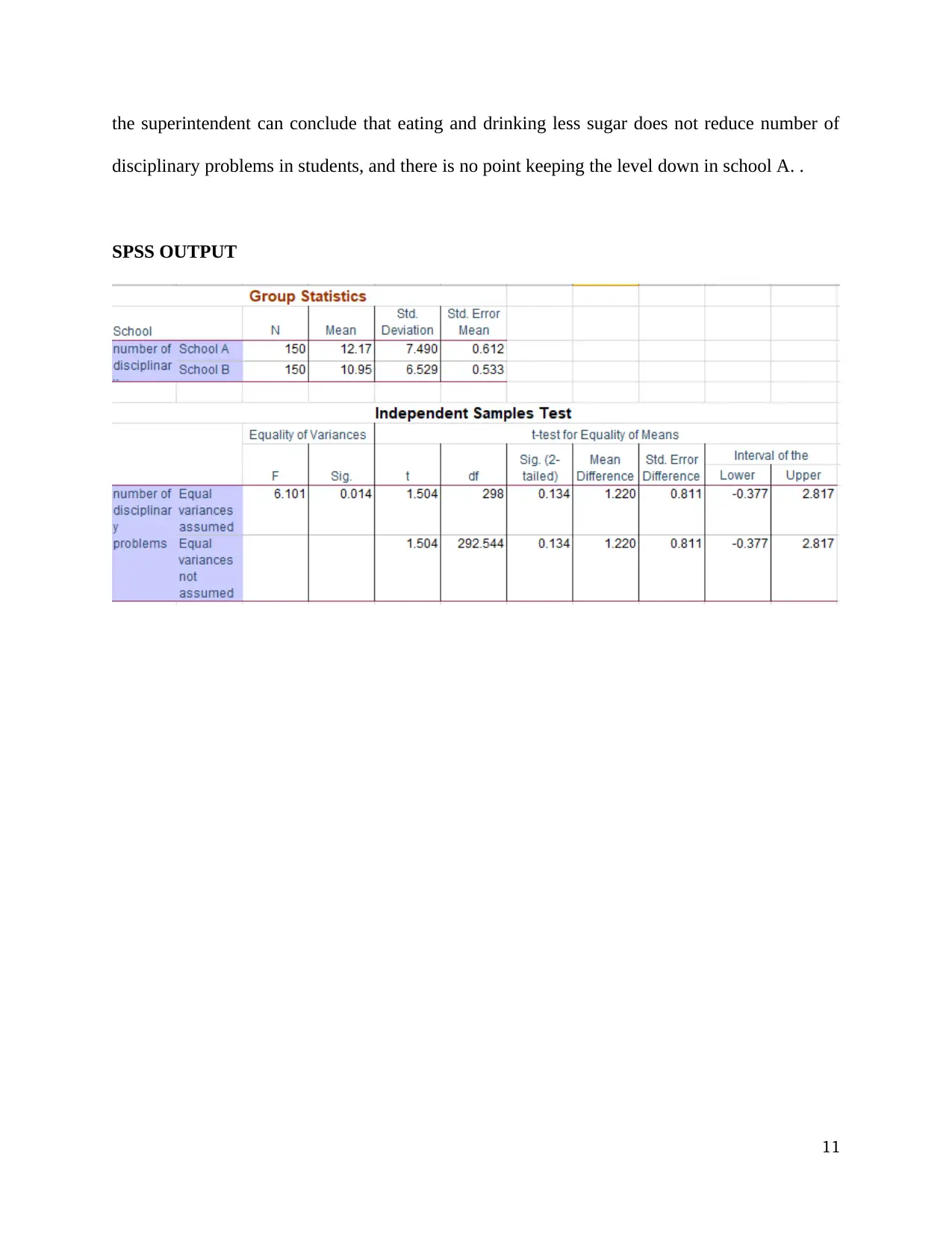
the superintendent can conclude that eating and drinking less sugar does not reduce number of
disciplinary problems in students, and there is no point keeping the level down in school A. .
SPSS OUTPUT
11
disciplinary problems in students, and there is no point keeping the level down in school A. .
SPSS OUTPUT
11
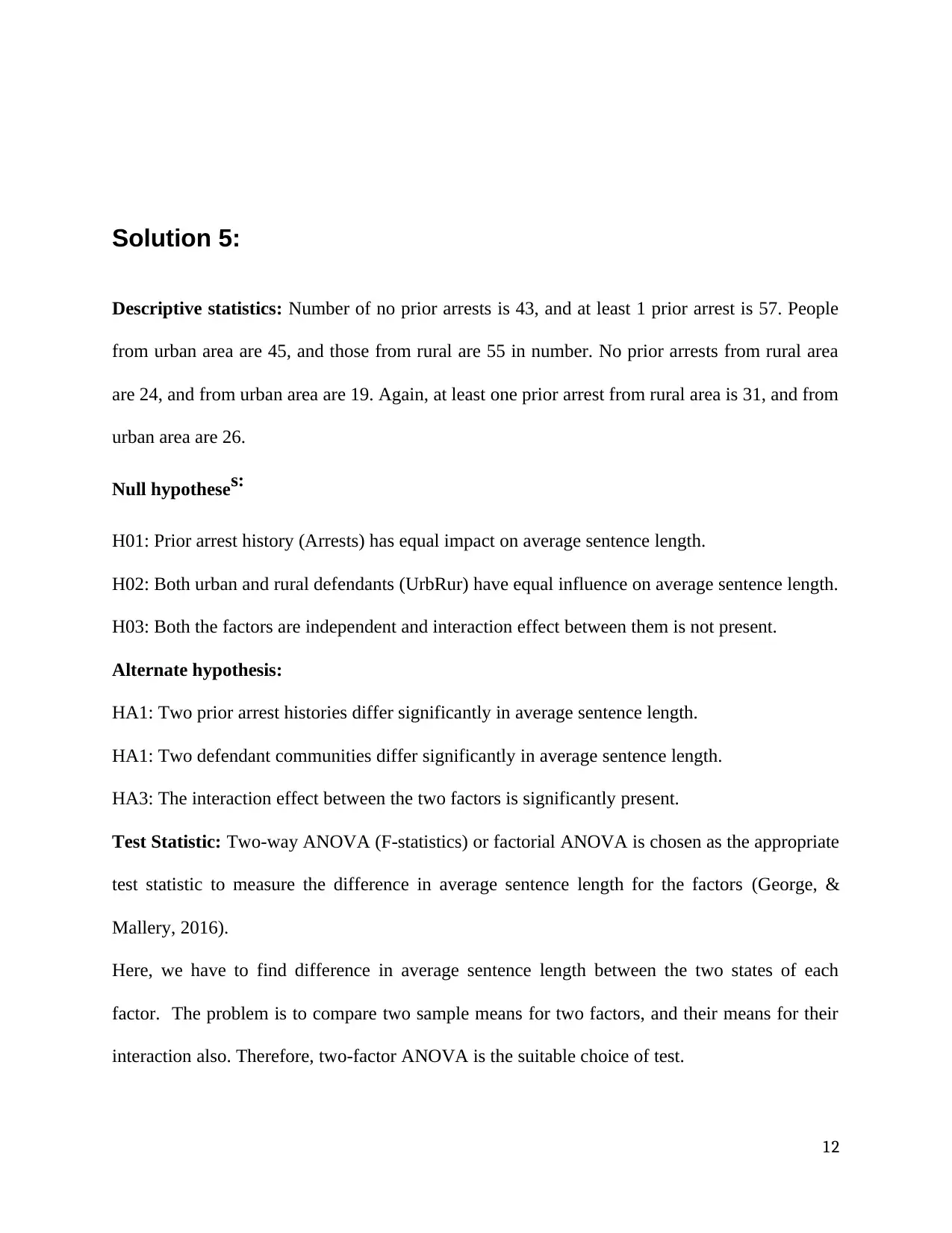
Solution 5:
Descriptive statistics: Number of no prior arrests is 43, and at least 1 prior arrest is 57. People
from urban area are 45, and those from rural are 55 in number. No prior arrests from rural area
are 24, and from urban area are 19. Again, at least one prior arrest from rural area is 31, and from
urban area are 26.
Null hypotheses:
H01: Prior arrest history (Arrests) has equal impact on average sentence length.
H02: Both urban and rural defendants (UrbRur) have equal influence on average sentence length.
H03: Both the factors are independent and interaction effect between them is not present.
Alternate hypothesis:
HA1: Two prior arrest histories differ significantly in average sentence length.
HA1: Two defendant communities differ significantly in average sentence length.
HA3: The interaction effect between the two factors is significantly present.
Test Statistic: Two-way ANOVA (F-statistics) or factorial ANOVA is chosen as the appropriate
test statistic to measure the difference in average sentence length for the factors (George, &
Mallery, 2016).
Here, we have to find difference in average sentence length between the two states of each
factor. The problem is to compare two sample means for two factors, and their means for their
interaction also. Therefore, two-factor ANOVA is the suitable choice of test.
12
Descriptive statistics: Number of no prior arrests is 43, and at least 1 prior arrest is 57. People
from urban area are 45, and those from rural are 55 in number. No prior arrests from rural area
are 24, and from urban area are 19. Again, at least one prior arrest from rural area is 31, and from
urban area are 26.
Null hypotheses:
H01: Prior arrest history (Arrests) has equal impact on average sentence length.
H02: Both urban and rural defendants (UrbRur) have equal influence on average sentence length.
H03: Both the factors are independent and interaction effect between them is not present.
Alternate hypothesis:
HA1: Two prior arrest histories differ significantly in average sentence length.
HA1: Two defendant communities differ significantly in average sentence length.
HA3: The interaction effect between the two factors is significantly present.
Test Statistic: Two-way ANOVA (F-statistics) or factorial ANOVA is chosen as the appropriate
test statistic to measure the difference in average sentence length for the factors (George, &
Mallery, 2016).
Here, we have to find difference in average sentence length between the two states of each
factor. The problem is to compare two sample means for two factors, and their means for their
interaction also. Therefore, two-factor ANOVA is the suitable choice of test.
12
⊘ This is a preview!⊘
Do you want full access?
Subscribe today to unlock all pages.

Trusted by 1+ million students worldwide
1 out of 30
Related Documents
Your All-in-One AI-Powered Toolkit for Academic Success.
+13062052269
info@desklib.com
Available 24*7 on WhatsApp / Email
![[object Object]](/_next/static/media/star-bottom.7253800d.svg)
Unlock your academic potential
Copyright © 2020–2025 A2Z Services. All Rights Reserved. Developed and managed by ZUCOL.



